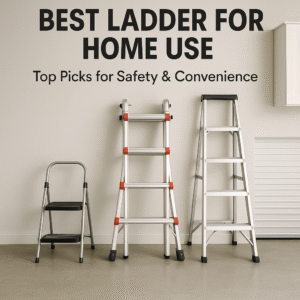Best Ladder for Home Use: Top Picks for Safety & Convenience
Whether you’re changing a lightbulb, cleaning gutters, or painting a room, a reliable ladder is one of the most essential tools a homeowner can possess. But not all ladders are created equal. Choosing the wrong one can turn a simple task into a dangerous ordeal. The right ladder, however, provides stability, safety, and the confidence to tackle any household project that’s just out of reach. In this guide, we’ll climb through the details to help you find the perfect ladder for your home—one that’s safe, convenient, and built to last.
Why Trust Our Recommendations?
Experience & Expertise: Our team has spent countless hours researching, analyzing user reviews, and consulting with home improvement experts to understand what truly makes a ladder great for everyday home use. We’ve sifted through dozens of models, focusing on those that meet or exceed ANSI (American National Standards Institute) safety standards. Our recommendations are based on a combination of real-world user feedback, material quality, design innovation, and overall value. We’re not just listing products; we’re providing trustworthy advice backed by thorough research to ensure your safety and satisfaction.
Understanding the Different Types of Ladders
Before you make a purchase, it’s crucial to understand the main types of ladders available. The best ladder for painting a two-story exterior is very different from the one you need to reach the top kitchen cabinet.
1. Step Ladders (A-Frame)
This is the most common type for indoor tasks. Step ladders are self-supporting A-frame ladders, perfect for jobs like changing smoke detector batteries, painting trim, or reaching high shelves. They are stable and easy to set up.
2. Extension Ladders
For outdoor jobs that require significant height, like cleaning second-story windows or accessing the roof, an extension ladder is necessary. These consist of two or more sections that slide apart to extend their reach. They are not self-supporting and must be leaned securely against a solid structure.
3. Multi-Position (Articulating) Ladders
Often called the “do-it-all” ladder, a multi-position ladder can be configured in various ways: as an A-frame step ladder, an extension ladder, a staircase ladder (with one side shorter than the other), or even as a base for a scaffold plank. Their versatility is unmatched, though they are typically heavier than other types.
Key Factors to Consider Before Buying a Ladder
Choosing the right ladder involves more than just picking the tallest one. Here are the critical factors to keep in mind to ensure you get the perfect tool for your needs.
- Height and Reach: Consider the highest point you need to reach. For a step ladder, remember that you should never stand on the top cap or the step just below it. For an extension ladder, it should extend at least 3 feet above the roofline or support point for safe access.
- Weight Capacity (Duty Rating): Ladders have duty ratings that indicate their maximum weight capacity. This includes your body weight plus the weight of any tools and materials you’re carrying. For general home use, a Type I (250 lbs), Type IA (300 lbs), or Type IAA (375 lbs) rating is recommended.
-
Material: Aluminum vs. Fiberglass:
- Aluminum: Lightweight, corrosion-resistant, and generally less expensive. It’s an excellent choice for most home tasks. However, aluminum conducts electricity, so it should never be used when working near electrical wires.
- Fiberglass: Heavier and more expensive, but it does not conduct electricity, making it the only safe choice for electrical work. It’s also more durable and resistant to weathering.
- Safety Features: Look for non-slip feet, deep, serrated steps for better grip, and sturdy spreader bars on step ladders to prevent over-extension. For extension ladders, ensure the rung locks are robust and easy to operate.
- Storage and Portability: Where will you store the ladder? A bulky extension ladder might be difficult to store in a small garage. Consider the ladder’s folded size and weight. If you’ll be moving it frequently, a lighter model will be a significant advantage.
Our Top Picks: The Best Ladders for Home Use in 2025
After extensive research, we’ve selected the best ladders across different categories. These picks balance safety, functionality, durability, and user satisfaction.
1. Best Overall Step Ladder: Little Giant Ladders Flip-N-Lite

Little Giant Ladders, Flip-N-Lite, 6-Foot
The Little Giant Flip-N-Lite isn’t just a ladder; it’s a testament to smart design. It hits the sweet spot for home use with its incredibly lightweight aluminum frame, making it a breeze to carry from the garage to the living room. You’ll immediately notice how secure it feels underfoot. The standing platform is extra-large, providing a stable and comfortable base that eliminates the foot fatigue common with standard rungs. The tall safety handrail gives you something solid to hold onto, offering a huge boost in confidence when you’re reaching for that last spot on the wall with a paintbrush. It’s the perfect tool for homeowners who want maximum safety without the bulk.
Pros
- Exceptionally lightweight and easy to carry
- Large, comfortable standing platform
- High safety rail for added stability
- Slim profile for easy storage
- Type IA duty rating (300 lbs)
Cons
- Only suitable for tasks within its height range
- Not designed for outdoor high-reach jobs
| Type | Step Ladder (A-Frame) |
|---|---|
| Height | 6 feet |
| Material | Aluminum |
| Weight Capacity | 300 lbs (Type IA) |
| Weight | 14 lbs |
2. Best Multi-Position Ladder: Gorilla Ladders 18 ft. Reach MPXA

Gorilla Ladders 18 ft. Reach MPXA Aluminum Multi-Position Ladder
If you could only own one ladder, this would be it. The Gorilla Ladders MPXA is the Swiss Army knife of the ladder world. Its versatility is truly impressive; in minutes, you can transform it from a sturdy A-frame for trimming hedges into a tall extension ladder for clearing gutters. The oversized hinges are incredibly robust and easy to adjust, locking into place with a reassuring click. It feels rock-solid in every configuration. While it’s heavier than a standard step ladder, its functionality more than compensates. For homeowners with diverse needs—from indoor painting to outdoor maintenance—this ladder replaces an entire collection of tools, saving you space and money. Thinking about the costs of home projects? Investing in a versatile tool like this is a smart move, which ties into learning how to budget for a family of four by making smart, long-term purchases.
Pros
- Extremely versatile with multiple configurations
- Heavy-duty construction and very stable
- High weight capacity (300 lbs)
- Relatively easy to adjust with speed locks
- Excellent value for its functionality
Cons
- Heavier than single-purpose ladders
- Can be a bit cumbersome to maneuver and set up
| Type | Multi-Position |
|---|---|
| Max Reach | 18 feet (as extension) |
| Material | Aluminum |
| Weight Capacity | 300 lbs (Type IA) |
| Weight | 34 lbs |
3. Best Lightweight Extension Ladder: Louisville Ladder 16′ Aluminum

Louisville Ladder AE2216 16-Foot Aluminum
When you need to get up high without wrestling a heavyweight ladder, the Louisville AE2216 is a fantastic choice. This 16-foot aluminum extension ladder is surprisingly light, making it manageable for one person to set up and move around the house. The D-shaped rungs provide a more stable and comfortable surface to stand on than traditional round rungs. The patented QuickLatch system is a standout feature, securely locking the sections together with a simple, one-finger operation. Safety is paramount, and the swiveling steel shoes with non-slip treads can be used on hard surfaces or spiked for soft ground, ensuring a solid footing wherever you place it. This is an ideal, no-fuss extension ladder for essential outdoor tasks.
Pros
- Lightweight and easy to handle
- D-shaped rungs for better stability
- Smooth operation with QuickLatch rung locks
- Durable, mar-resistant end caps protect surfaces
- Excellent for standard two-story home maintenance
Cons
- Lower weight rating (225 lbs) than other picks
- Not as versatile as a multi-position ladder
| Type | Extension Ladder |
|---|---|
| Length | 16 feet |
| Material | Aluminum |
| Weight Capacity | 225 lbs (Type II) |
| Weight | 21.5 lbs |
4. Best Compact Step Stool: HBTower 3 Step Ladder

HBTower 3 Step Ladder with Handrails
For those everyday “just out of reach” moments, a full-sized ladder is overkill. That’s where the HBTower 3 Step Ladder shines. This isn’t just a step stool; it’s a small, incredibly secure platform. It arrives fully assembled and folds down to a mere 4.5 inches thick, so you can slide it into a closet or next to the fridge with ease. The wide, textured steps and padded handgrip provide a sense of security that flimsy kitchen stools can’t match. It’s the perfect companion for reaching the top shelf of your pantry, hanging pictures, or even while working on your garden. In fact, if you’re looking for ways to spend more quality time at home, you might find inspiration in learning how to grow your own vegetables at home, and this stool is perfect for tending to taller plants.
Pros
- Folds extremely thin for easy storage
- Wide, anti-slip steps offer great stability
- Comfortable padded handgrip
- Comes fully assembled
- High weight capacity (500 lbs) for its size
Cons
- Limited height for bigger projects
- Slightly heavier than basic step stools
| Type | Step Stool / Ladder |
|---|---|
| Steps | 3 |
| Material | Steel |
| Weight Capacity | 500 lbs |
| Weight | 16.5 lbs |
Ladder Safety: The Golden Rules
Owning a great ladder is only half the battle; using it safely is what truly matters. According to the American Ladder Institute, over 500,000 people are treated for ladder-related injuries each year. Don’t become a statistic.
- Inspect Before Use: Before every use, check for loose rungs, cracked rails, or damaged feet. Never use a damaged ladder.
- Choose the Right Spot: Place your ladder on firm, level ground. Avoid wet, slippery, or soft surfaces.
- The 4-to-1 Rule: For extension ladders, the base should be one foot away from the wall for every four feet of height to the point of support.
- Maintain Three Points of Contact: Always keep two hands and one foot, or two feet and one hand, on the ladder when climbing or descending.
- Don’t Overreach: Keep your hips within the ladder’s rails. It’s better to get down and move the ladder than to stretch and risk losing your balance.
- Face the Ladder: Always face the ladder when climbing up or down.
- Avoid Electrical Hazards: Never use an aluminum ladder near power lines or any electrical work. Use fiberglass instead.
Completing home projects efficiently and safely can be a great stress reliever and contributes to a better balance between work and family life.
Frequently Asked Questions (FAQ)
What is the best all-around ladder for a new homeowner?
For a new homeowner, a high-quality multi-position ladder like the Gorilla Ladders 18 ft. Reach MPXA offers the best value and versatility. It can handle nearly any task, from indoor A-frame use to outdoor extension needs, saving you from buying multiple ladders.
How tall of a ladder do I need for a 2-story house?
To safely reach the gutters or roof of a typical 2-story house, you’ll generally need a 24 to 28-foot extension ladder. This provides enough length to have the required 3-foot extension above the roofline for safe transitions.
Is an aluminum or fiberglass ladder better for home use?
For general home use where you are not working near electricity, an aluminum ladder is often better because it is lighter and less expensive. However, if you plan to do any work near electrical lines or outlets, a fiberglass ladder is the only safe option as it does not conduct electricity.
How do I store my ladder properly?
Store your ladder in a dry, protected area to prevent weathering and rust. You can hang it horizontally on sturdy wall hooks or store it vertically if it’s secured to prevent it from falling. Avoid exposing it to excessive heat or direct sunlight for prolonged periods.
Conclusion: Reaching New Heights Safely
A ladder is a fundamental tool that empowers you to maintain and improve your home. Choosing the right one is a critical investment in both your capability and your safety. By considering your specific needs—whether it’s the lightweight convenience of the Little Giant Flip-N-Lite for indoor tasks, the incredible versatility of the Gorilla MPXA, the straightforward reach of the Louisville extension ladder, or the compact utility of the HBTower step stool—you can find the perfect partner for your projects. Always prioritize safety, follow best practices, and you’ll be well-equipped to tackle any task that comes your way.


